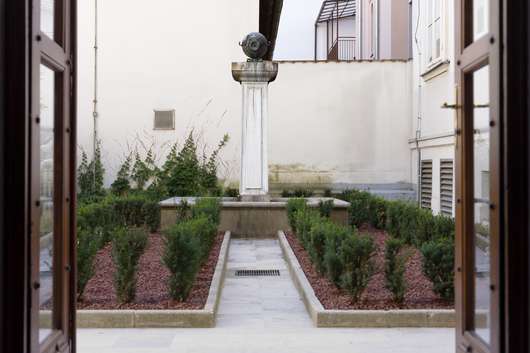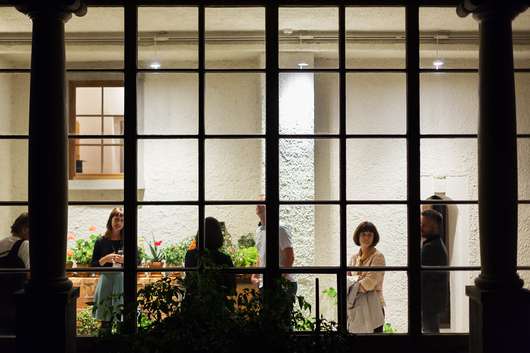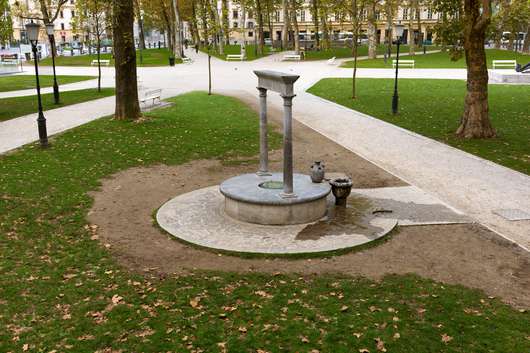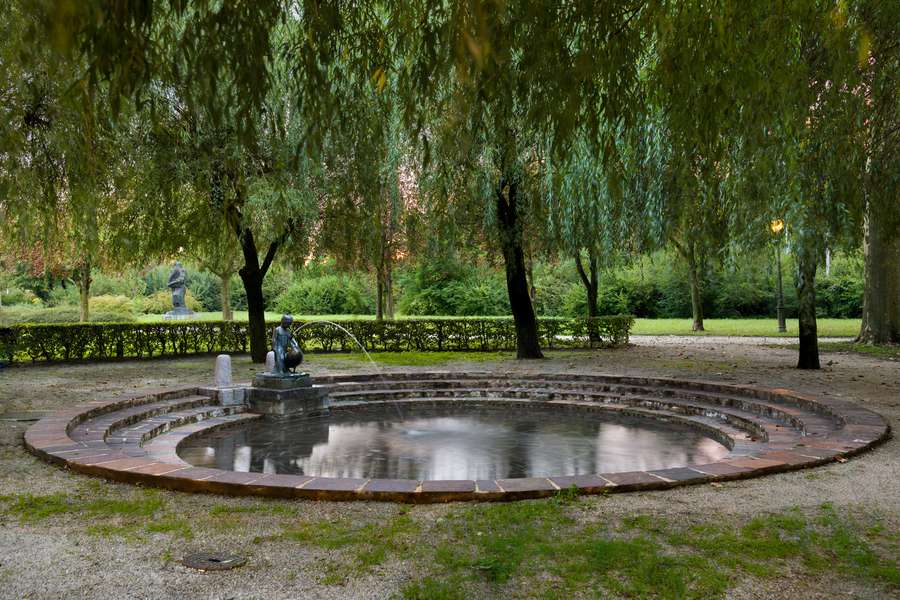Plečnik and water: the fountains in the city
With Plečnik's year coming to its end, visitors to the Plečnik House can now visit the temporary exhibition Plečnik and water: the fountains in the city, which gives them a peek into the original materials of the Plečnik Collection and the architect's plans for various projects connected with water.
Water inspired Plečnik since the beginning of his career. He included it in his early works in Vienna, it played an important role at the Prague Castle renovation, while the most important projects connected with water Plečnik executed in Ljubljana itself, where he worked on the Ljubljanica riverbanks. Plečnik and water: the fountains in the city does not focus on Plečnik's most important projects, but rather on his ideas and executions of minor solutions in which he included water as a symbol of life and purification. Ana Porok, author of the exhibition, explained, "In his oeuvre Plečnik also dedicated attention to the design of fountains. To him, the flowing element of water was a complementation and regeneration of static architecture. In his late career, Plečnik often thought about different combinations of monuments in symbiosis with water, which is nicely shown in a series of original sketches and plans at the exhibition. Sadly his ideas were not realised."
The exhibition, which focuses on Plečnik's ideas for the fountains and monuments in Ljubljana, is complemented by the architect's solution for the fountain by the Rosary Church in Kranj. This work by Plečnik was the inspiration for the artist Lela B. Njatin to create an original tale titled The Artist and the Bird, which will be presented to the public at the Plečnik House. The tale is also a part of the exhibition Plečnik and water.
The exhibition is supported by the Ministry of Environment and Spatial Planning and is part of the Sustainable spatial development month 2017, event, this year under the title Green Space Connects. "By choosing the central theme of the Sustainable spatial development month 2017 we want to shed light on the development and protection aspects of connecting and complementing green spaces, and on the role played by sustainable development in all of this. A connected green space is the motto of future spatial development, which will also be included in the new Spatial Development Strategy of Slovenia 2030, which is currently being prepared," the Ministry explained the importance of the project. The full project is available here (in Slovenian). The exhibition, connected with Plečnik's work with water, is also supported by the public company VODOVOD-KANALIZACIJA.
About the Exhibition
Water was often a source of inspiration to Plečnik, often he sought harmony between the static nature of architecture and refining it through the dynamism of water.
As a young architect he, alongside sculptor Josef Engelhart, designed the St Charles Borromeo Fountain in a small Viennese oval park in 1909. The memorial with its triangular obelisk, was designed to commemorate the 60th birthday of the mayor of Vienna, Karel Lüger. Plečnik designed the obelisk plinth and the vases on the fence. The Robba’s fountain, in front of Ljubljana's City Hall, inspired Plečnik in this project.
In renovating the Prague Castle (1920−1934), for the first democratically elected president of Czechoslovakia, T. G. Masaryk, he preserved the existing fountains and designed a series of new ones with symbolic meanings. In the Third Courtyard, he enclosed the St George Fountain with a raised ring, symbolising a halo; he left the Eagle Fountain in its original place in front of the Vladislav Hall and architecturally supplemented it. Inside president’s private quarters, he designed an impluvium with a central monolithic granite fountain and a wall mounted washbasin in the library; for the space at the upper stair landing to the Paradise Garden, he designed a fountain with a baroque lion head and a symbolic inscription SEMPER (always). He also designed a vase fountain at the foot of the Paradise Garden stairway.
In Ljubljana he was simultaneously busy planning the Chamber of Commerce, Work and Industry (1927; today the Constitutional Court of Slovenia). There, he set a fountain in the courtyard with a plinth very similar to that of the St George Fountain at the Prague Castle.
The fence around the St Peter’s Parish Church property was one of his early projects in Ljubljana; completed in 1932, he integrated a symmetrical fountain into the fence, which was designed as the reflection of a rosette in the fence.
At the Tivoli Park entrance, Plečnik created a small triangular park (1933) intended for children. Within it, he placed a shallow round pool deepened by five concentric steps and decorated with the sculpture Boy with a Goose by France Gorše.
He wished to revive several medieval fountains in Ljubljana, and was successful in doing so when remodelling St James’s Square (1927), where he placed a fountain at the location of the previous one, which was lost after the Jesuit College was demolished due to fire. He was also successful in Zvezda Park (1941), where his student and then city architect Boris Kobe carried on reconstruction works and heeded his professor’s wish regarding the revival of the old fountain of the Capuchin monastery in the form of a public water tap. Plečnik also preserved the old fountain of the fortress at Šance (ca 1934) to which he added a cylindrical stone structure and an arch covering it.
Furthermore, he did not forget about the needs of passers-by when constructing Ljubljana’s main market (1942) where the artificial stone wash basins in a loggia are very functionally shaped and intended for all.
The fountain at Žale (1940) is set in front of the St Nicholas Chapel, patron of Ljubljana’s cathedral. It is built from the stone left over after the redesigning of the column of the Virgin Mary at St James’s Square. It was meant to be decorated with a wrought copper sculpture of a cockerel by the sculptor Božo Pengov. In the end, it was not fitted to the fountain, and Plečnik later used it as a decoration of the fountain by the Rosary Church in Kranj (1955). There he imagined a staircase with a fountain as a completely designed grand entrance to the old city core.
The Liberation Front monument in front of Vidmar’s villa in Ljubljana (1951) had an interesting original design: Plečnik conceived it as a wall fountain whose seven water jets were supposed to symbolise the vital force of the Slovenian people, but it has never functioned as a fountain.
Many of his ideas for fountains, and later for monuments incorporating water, remained unrealised: thus, the fountain to be built on Zoisova Road, opposite the Faculty of Architecture, remained only in his plans from 1927, while the plans for a fountain in the entrance hall of the Chamber of Commerce, Work and Industry from 1927 are unfortunately lost.
The proposed design for a new Slovenian parliament from 1947, the so-called Cathedral of Freedom, also needs mentioning. In its cellar underneath the central round hall he planned a monumental fountain as a symbolic source of life and wisdom.
Fountains convey many symbolic messages, signifying a source of life, of regeneration, knowledge, wisdom, a means of purification, a symbol of abundance and mystery... Plečnik knew how to adapt their forms to a variety of requirements and the places where they were sited.
—Ana Porok
Colophon
PLEČNIK AND WATER: the fountains in the city, temporary exhibition, 13. 10. 2017–21. 1. 2018, Museum and Galleries of Ljubljana / Plečnik House, represented by: Blaž Peršin, Director
Curator of the exhibition and text for the brochure: Ana Porok
Photographs by: Andrej Peunik, MGML documentation
Short film: Andrej Peunik, Matej Župec
Author of the fairy tale “The Artist and the Bird”: Lela B. Njatin
Graphic and exhibition design: Bojan Lazarevič, Agora Proars
Language editing: Katja Paladin, Terry T. Jackson
English translation: Milan Stepanovič, Studio Phi, d.o.o., Matic Šavli
Conservation of the materials: mag. Katarina Toman Kracina
Documentation: Matej Satler
Promotion: Maja Kovač, Tamara Bregar
Exhibition layout: OKvir, Technical services of MGML
Location
Karunova 4–6
1000 Ljubljana
T +386 1 280 16 04 (reception)
T +386 1 241 25 06
E plecnik@mgml.si
Opening hours
Tuesday–Sunday: 10:00–18:00
Monday: Closed
1 January, 1 November, 25 December: Closed
24 and 31 December: 10:00–14:00
Tickets
Visits of the original Plečnik’s home are only possible with a guided tour that begins every full hour. In case the visitors on the guided tours come from different countries, each tour is conducted in two languages – Slovenian and English.
RECOMMENDED: you can buy your tickets online and book your date here.
For more information, please contact plecnik@mgml.si or +386 1 280 16 04.
Visiting the Plečnik House (price includes permanent exhibition Plečnik and a guided tour of Plečnik's home)
Adults: 9 €
Students: 7 €
Children: 7 €
Children up to the age of 6: Admission free
Adults over the age of 60: 7 €
Families: 18 €
Unemployed visitors: 7 €
Visitors with disabilities: 7 €
Free admission for carers
ICOM, PRESS, SMD: free admission
Guided tours for private groups of more than 7 visitors need to be booked at least 5 working days in advance.
Visiting the Plečnik House with a prior reservation
Groups of up to 5 persons: 50 €, 40 € at reduced price
Groups of over 5 persons: 10 €/person, reduced 8 €/person
Visiting the permanent exhibition Plečnik
Adults: 6 €
Students: 4 €
Children: 4 €
Children up to the age of 6: Admission free
Adults over the age of 60: 4 €
Families: 12 €
Unemployed visitors: 4 €
Visitors with disabilities: 4 €
Free admission for carers
ICOM, PRESS, SMD: free admission
Events




